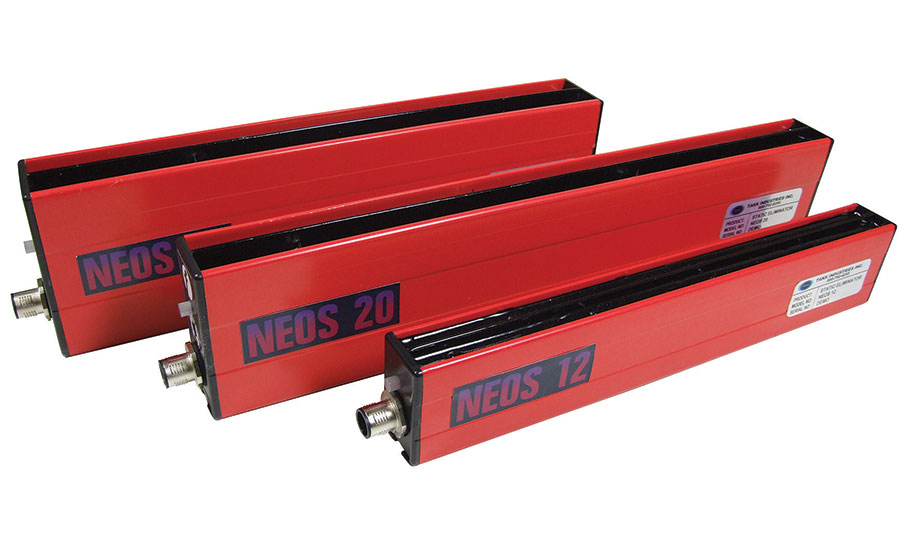Technology: Static Control
Battling Static

The winter often brings expectations of colder, lower humidity weather and the right conditions for generating static electricity in flexible packaging processes. High humidity environments are less conducive to the generation of static electricity whereas dryer, low humidity conditions act to encourage the creation of static.
Static electricity can generate anywhere there is contact and separation or friction between processes materials (i.e. where film makes contact with rollers, guides and other surfaces). It is very common to see static charges accumulate in production processes at values of 15,000 volts to 35,000 volts. In some applications, such as high-speed film winding, voltages in excess of 75,000 volts can be present.
If static electricity is not properly controlled in flexible packaging processes, many preventable issues can occur. These include lower productivity, increased rejects due to quality impairments and personnel discomfort and dissatisfaction – all important issues that impact a company’s bottom line.
Primary Problems Caused by Unchecked Static Electricity
Lower Production: Static can create a situation where a flexible film process cannot run at optimal speed due to clinging of the materials to itself, feed or conveyance components. In some cases, the machine process will not function at all in the presence of moderate static charges.
Quality Impairment: As the level of static increases, more and more contamination will be drawn from the surrounding environment and electrostatically bonded to the film. This can cause defects and rejects in sealing, laminating and winding operations. Static can cause imperfections when printing on films, as ink follows the electrostatic field pattern on the surface of the film causing poor printing impressions.
Personnel Shock: Shock from static discharge is a significant concern. Static shock can range from mild discomfort to a very painful experience for anyone working near or handling film products such as a highly-charged film rolls. Additionally, there is a hazard factor due to a person’s recoil response from a static discharge when working around sharp or moving machine parts.
New Static Control Technology Solutions
The key to preventing static-related problems is maintaining positive and consistent control of static electricity throughout a process. New advances in intelligent static control have brought about significant advances in static elimination and management. For example, new reactive intelligent static control technology now makes it easier to take positive control over static caused production problems. New, advanced bars provide an easy to operate solution incorporating reactive intelligent features, thereby allowing for the detection and delivery of only exactly the amount of ionization required. A powerful integrated power supply, compact size, shockless operation, remote monitoring and built in “clean me” indicators on board the ionizer are other features of this new development.
The Harmful Impact of Static Electricity
A classic example of static issues in flexible packaging would be a roll winding process. Because of static attraction, the film may not wind properly on the roll producing telescoping and baggy areas. Also, contamination attraction due to static charge can cause trim, airborne contaminates or excessive slitter dust to be wound into the roll. The accumulating static charges between each layer of film as it is being wound builds the level of static charge potential to the point where handling, or even being in close proximity to the roll, can cause a painful static discharge for production floor personnel. Another undesirable consequence of uncontrolled static electricity is its tendency to interfere with or cause serious damage to sensitive electronic web controls, such as defect detection cameras, web edge sensors and other high-value electronic controls that are installed along a web’s path.
A sometime overlooked, but very important issue, is that if the roll is being sent to a customer for further processing, the static remains in the roll. When the customer attempts to process the roll they will likely encounter multiple static-caused production issues, resulting in customer dissatisfaction.
In Conclusion
Static electricity is an accumulative phenomenon. When static issues are observed in flexible packaging processes, a good rule of thumb is to position the static eliminator just prior to any point of problem. The goal is to remove or lower the static charge before it has a chance to cause dust and contamination to be attracted to the film, or cause jamming, misalignment or printing defects.
Proper application and use of the most capable static control technologies is important to ensuring efficient, profitable flexible packaging operations.
TAKK
(800) 792-8255
www.takk.com
Looking for a reprint of this article?
From high-res PDFs to custom plaques, order your copy today!








